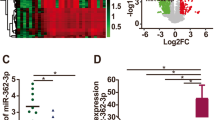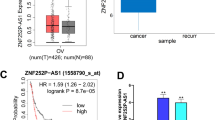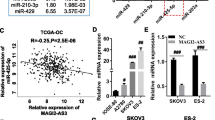Abstract
This study aimed to explore the role of miR-339-5p in ovarian cancer. The expression of miR-339-5p in seven ovarian cancer cell lines (Hey, SKOV3, OVCAR5, SKOV3-IP, A2780, CAOV3, and OVCA433) was detected by quantitative real-time polymerase chain reaction (qRT-PCR). The miR-339-5p mimic and inhibitor were used to regulate its expression. Migration, invasion, and proliferation were examined. A bioinformatics analysis was used to predict targets, and a dual-luciferase reporter system was applied for validation, along with Western blot verification. Additionally, the association of miR-339-5p and its target genes with ovarian cancer was analyzed based on The Cancer Genome Atlas (TCGA) database. OVCAR5 and SKOV3 had the highest and lowest miR-339-5p expression, respectively. Inhibition of miR-339-5p expression increased the migration and invasion of OVCAR5 cells, while in SKOV3 cells, upregulated miR-339-5p attenuated the migration and invasion ability. Modulation of miR-339-5p had no effect on proliferation. The genes nucleus accumbens associated 1(BEN and BTB (POZ) domain containing) (NACC1) and B cell lymphoma-6 (bcl6) were validated to be targets of miR-339-5p. Clinically, patients with a high expression of NACC1 had a high risk in the survival analysis. miR-339-5p inhibits migration and invasion in ovarian cancer by targeting NACC1 and BCL6. miR-339-5p may be a biomarker of metastasis in ovarian cancer; NACC1 had a predictive value for ovarian cancer progression.





Similar content being viewed by others
References
Yeung TL, Leung CS, Yip KP, Au Yeung CL, Wong ST, Mok SC. Cellular and molecular processes in ovarian cancer metastasis. A review in the theme: cell and molecular processes in cancer metastasis. Am J Physiol Cell Physiol. 2015;309:C444–56.
Oktay K, Turan V, Titus S, Stobezki R, Liu L. BRCA mutations, DNA repair deficiency, and ovarian aging. Biol Reprod. 2015;93:67.
Torres A, Torres K, Maciejewski R, Harvey WH. MicroRNAs and their role in gynecological tumors. Med Res Rev. 2011;31:895–923.
Ma L, Teruya-Feldstein J, Weinberg RA. Tumour invasion and metastasis initiated by microRNA-10b in breast cancer. Nature. 2007;449:682–8.
Cui J, Li D, Zhang W, Shen L, Xu X. Bioinformatics analyses combined microarray identify the deregulated microRNAs in oral cancer. Oncol Lett. 2014;8:218–22.
Guo WG, Zhang Y, Ge D, Zhang YX, Lu CL, Wang Q, et al. Bioinformatics analyses combined microarray identify the desregulated microRNAs in lung cancer. Eur Rev Med Pharmacol Sci. 2013;17:1509–16.
Barroso-delJesus A, Romero-Lopez C, Lucena-Aguilar G, Melen GJ, Sanchez L, Ligero G, et al. Embryonic stem cell-specific miR302-367 cluster: human gene structure and functional characterization of its core promoter. Mol Cell Biol. 2008;28:6609–19.
Deng G, Sui G. Noncoding RNA in oncogenesis: a new era of identifying key players. Int J Mol Sci. 2013;14:18319–49.
Su JL, Chen PS, Johansson G, Kuo ML. Function and regulation of let-7 family microRNAs. MicroRNA. 2012;1:34–9.
Zhang CL, Li Z, Liu YP, Wu Y, Qu XJ. Prognostic role of the let-7 family in various carcinomas: a meta-analysis update. J BUON. 2015;20:631–44.
Bartel DP. MicroRNAs: genomics, biogenesis, mechanism, and function. Cell. 2004;116:281–97.
Gyorffy B, Lanczky A, Szallasi Z. Implementing an online tool for genome-wide validation of survival-associated biomarkers in ovarian-cancer using microarray data from 1287 patients. Endocr Relat Cancer. 2012;19:197–208.
Gyorffy B, Surowiak P, Budczies J, Lanczky A. Online survival analysis software to assess the prognostic value of biomarkers using transcriptomic data in non-small-cell lung cancer. PLoS One. 2013;8:e82241.
Wu ZS, Wu Q, Wang CQ, Wang XN, Wang Y, Zhao JJ, et al. MiR-339-5p inhibits breast cancer cell migration and invasion in vitro and may be a potential biomarker for breast cancer prognosis. BMC Cancer. 2010;10:542.
Zhou C, Liu G, Wang L, Lu Y, Yuan L, Zheng L, et al. MiR-339-5p regulates the growth, colony formation and metastasis of colorectal cancer cells by targeting PRL-1. PLoS One. 2013;8:e63142.
Li Y, Zhao W, Bao P, Li C, Ma XQ, Li Y, et al. miR-339-5p inhibits cell migration and invasion and may be associated with the tumor-node-metastasis staging and lymph node metastasis of non-small cell lung cancer. Oncol Lett. 2014;8:719–25.
Wang YL, Chen CM, Wang XM, Wang L. Effects of miR-339-5p on invasion and prognosis of hepatocellular carcinoma. Clin Res Hepatol Gastroenterol. 2015.
Rani S, Gately K, Crown J, O’Byrne K, O’Driscoll L. Global analysis of serum microRNAs as potential biomarkers for lung adenocarcinoma. Cancer Biol Ther. 2013;14:1104–12.
Jansson MD, Damas ND, Lees M, Jacobsen A, Lund AH. miR-339-5p regulates the p53 tumor-suppressor pathway by targeting MDM2. Oncogene. 2015;34:1908–18.
Liu DZ, Ander BP, Tian Y, Stamova B, Jickling GC, Davis RR, et al. Integrated analysis of mRNA and microRNA expression in mature neurons, neural progenitor cells and neuroblastoma cells. Gene. 2012;495:120–7.
Ishikawa M, Nakayama K, Yeasmin S, Katagiri A, Iida K, Nakayama N, et al. NAC1, a potential stem cell pluripotency factor expression in normal endometrium, endometrial hyperplasia and endometrial carcinoma. Int J Oncol. 2010;36:1097–103.
Shih Ie M, Davidson B. Pathogenesis of ovarian cancer: clues from selected overexpressed genes. Future Oncol. 2009;5:1641–57.
Nakayama K, Rahman MT, Rahman M, Yeasmin S, Ishikawa M, Katagiri A, et al. Biological role and prognostic significance of NAC1 in ovarian cancer. Gynecol Oncol. 2010;119:469–78.
Shih Ie M, Nakayama K, Wu G, Nakayama N, Zhang J, Wang TL. Amplification of the ch19p13.2 NACC1 locus in ovarian high-grade serous carcinoma. Mod Pathol. 2011;24:638–45.
Nakayama K, Nakayama N, Davidson B, Sheu JJ, Jinawath N, Santillan A, et al. A BTB/POZ protein, NAC-1, is related to tumor recurrence and is essential for tumor growth and survival. Proc Natl Acad Sci U S A. 2006;103:18739–44.
Gao M, Wu RC, Herlinger AL, Yap K, Kim JW, Wang TL, et al. Identification of the NAC1-regulated genes in ovarian cancer. Am J Pathol. 2014;184:133–40.
Zhang Y, Cheng Y, Ren X, Hori T, Huber-Keener KJ, Zhang L, et al. Dysfunction of nucleus accumbens-1 activates cellular senescence and inhibits tumor cell proliferation and oncogenesis. Cancer Res. 2012;72:4262–75.
Jinawath N, Vasoontara C, Yap KL, Thiaville MM, Nakayama K, Wang TL, et al. NAC-1, a potential stem cell pluripotency factor, contributes to paclitaxel resistance in ovarian cancer through inactivating Gadd45 pathway. Oncogene. 2009;28:1941–8.
Zhang Y, Cheng Y, Ren X, Zhang L, Yap KL, Wu H, et al. NAC1 modulates sensitivity of ovarian cancer cells to cisplatin by altering the HMGB1-mediated autophagic response. Oncogene. 2012;31:1055–64.
Zhang Y, Yang JW, Ren X, Yang JM. NAC1 and HMGB1 enter a partnership for manipulating autophagy. Autophagy. 2011;7:1557–8.
Nakayama K, Nakayama N, Miyazaki K. Development of a novel ovarian cancer molecular target therapy against cancer-related transcriptional factor, NAC1. J Obstet Gynaecol Res. 2013;39:18–25.
Yu JM, Sun W, Hua F, Xie J, Lin H, Zhou DD, et al. BCL6 induces EMT by promoting the ZEB1-mediated transcription repression of E-cadherin in breast cancer cells. Cancer Lett. 2015;365:190–200.
Wang W, Hu S, Lu X, Young KH, Medeiros LJ. Triple-hit B-cell lymphoma with MYC, BCL2, and BCL6 translocations/rearrangements: clinicopathologic features of 11 cases. Am J Surg Pathol. 2015;39:1132–9.
Deucher AM, Qi Z, Yu J, George TI, Etzell JE. BCL6 expression correlates with the t (1;19) translocation in B-lymphoblastic leukemia. Am J Clin Pathol. 2015;143:547–57.
Liang PI, Li CF, Chen LT, Sun DP, Chen TJ, Hsing CH, et al. BCL6 overexpression is associated with decreased p19 ARF expression and confers an independent prognosticator in gallbladder carcinoma. Tumour Biol. 2014;35:1417–26.
Wang YQ, Xu MD, Weng WW, Wei P, Yang YS, Du X. BCL6 is a negative prognostic factor and exhibits pro-oncogenic activity in ovarian cancer. Am J Cancer Res. 2015;5:255–66.
Walker SR, Liu S, Xiang M, Nicolais M, Hatzi K, Giannopoulou E, et al. The transcriptional modulator BCL6 as a molecular target for breast cancer therapy. Oncogene. 2015;34:1073–82.
Author information
Authors and Affiliations
Corresponding author
Ethics declarations
Conflicts of interest
None
Additional information
Weiwei Shan was the first author.
Electronic supplementary material
Below is the link to the electronic supplementary material.
Table S1
Primers list. (DOCX 14 kb)
Fig. S1
Luciferase activity of PAPPA and PRL1 3′UTR in SKOV3 cells. a Luciferase activity of the PAPPA 3′UTR reporter genes in SKOV3 cells. b The luciferase activity of PRL1 3′UTR reporter genes in SKOV3 cells. SKOV3 cells transfected with miR-339-5p mimic or its corresponding mimic control. The sequences of the miR-339-5p binding site are shown in the right panel. Student’s t test was used for the analysis. CTL, all stars negative control. (JPG 1024 kb)
Fig. S2
The survival analysis of BCL6 and miR-339-5p in serous ovarian cancer patients. HRs and 95% CIs and logrank p values are presented in the right quadrant of the plots. The numbers at risk are shown under the plot. a PFS analysis of BCL6. b PPS analysis of BCL6. c OS analysis of BCL6. d The survival analysis of miR-339-5p in ovarian cancer patients. The analysis was performed with GraphPad Prism 5.0. (GIF 279 kb)
Rights and permissions
About this article
Cite this article
Shan, W., Li, J., Bai, Y. et al. miR-339-5p inhibits migration and invasion in ovarian cancer cell lines by targeting NACC1 and BCL6. Tumor Biol. 37, 5203–5211 (2016). https://doi.org/10.1007/s13277-015-4390-2
Received:
Accepted:
Published:
Issue Date:
DOI: https://doi.org/10.1007/s13277-015-4390-2




